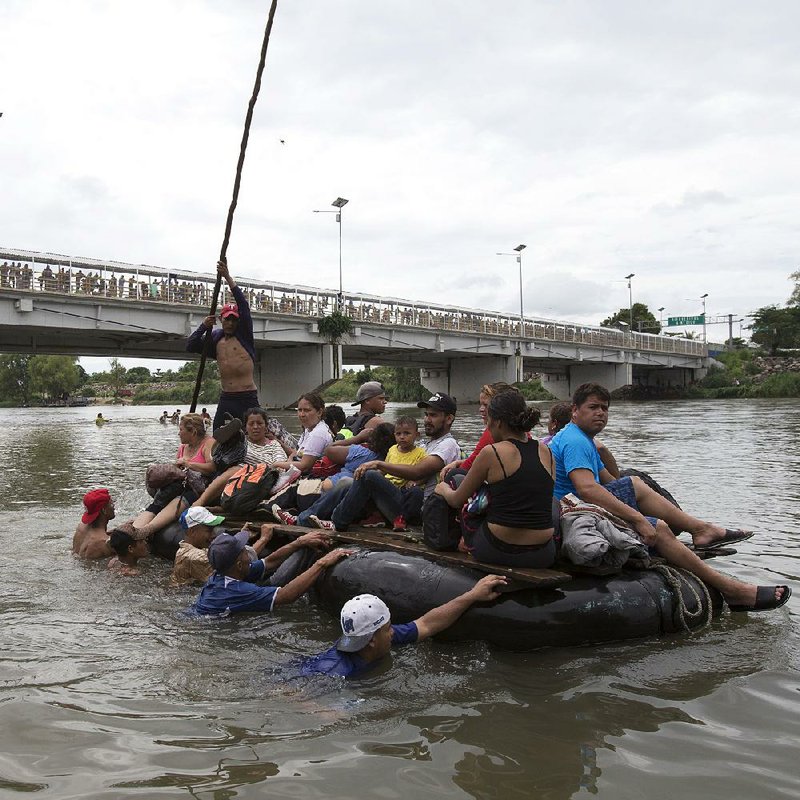CIUDAD HIDALGO, Mexico -- About 2,000 Central American migrants who circumvented Mexican police at a border bridge and swam, forded and floated across the river from Guatemala decided on Saturday to re-form their mass caravan and continue their trek northward toward the United States.
Gathered at a park in the border city of Ciudad Hidalgo, the migrants voted by a show of hands and then marched to the bridge to urge those still there to cross the Suchiate River and join them.
The group's decision capped a day in which Mexican authorities again refused mass entry to migrants on the bridge, instead accepting small groups for asylum processing and giving out 45-day visitor permits to some of them.
Mexico had sought to maintain order after a chaotic Friday in which thousands rushed across the bridge only to be halted by a phalanx of officers in riot gear. Authorities began handing out numbers for people to be processed in a strategy seen before at U.S. border posts when dealing with large numbers of migrants.
Where easily 3,000 people were on the bridge the previous day, the crowd had thinned out considerably by Saturday. In addition to those who crossed the river, immigration agents processed migrants in small groups and then bused them to an open-air, metal-roof fairground in Tapachula, where the Red Cross set up small blue tents on the concrete floor.
At an event in Scottsdale, Ariz., on Friday, U.S. President Donald Trump made it clear to Mexico that he is monitoring its response.
"So as of this moment, I thank Mexico. I hope they continue. But as of this moment, I thank Mexico," he said. "If that doesn't work out, we're calling up the military -- not the Guard."
He also warned the migrants that they should turn back.
"They're not coming into this country," he said.
"The Mexican Government is fully engaged in finding a solution that encourages safe, secure, and orderly migration," State Department spokesman Heather Nauert said Saturday, "and both the United States and Mexico continue to work with Central American governments to address the economic, security, and governance drivers of illegal immigration."
On Friday, Mexican police and immigration agents began letting small groups of 10, 20 or 30 people through the gates at a time if they wanted to apply for refugee status. Once they filed a claim, they were given the option to go to a shelter to spend the night.
Other migrants, tired of waiting, jumped off the bridge into the river. Some organized a rope brigade to ford its muddy waters or floated across on rafts operated by local residents who usually charge a dollar or two to make the crossing.
Hundreds of others awoke amid garbage that had already piled up on the bridge. Without restrooms, a foul odor wafted through the air.
Jose Yanez slept with no blanket, but vowed to continue.
"From here, we're going on. From here, there's no turning back," said the 25-year-old farmer, adding that he makes 150 lempiras a day in Honduras, or about $6, and has no work benefits.
Late Friday night, Mexican President Enrique Pena Nieto said that "Mexico does not permit and will not permit entry into its territory in an irregular fashion, much less in a violent fashion."
Honduran President Juan Orlando Hernandez tweeted late Friday that he spoke with his Guatemalan counterpart, Jimmy Morales, and asked permission to send Honduran civil protection personnel to the bridge to help the migrants.
"I also asked authorization to hire ground transportation for anyone who wants to return and an air bridge for special cases of women, children, the elderly and the sick," Hernandez tweeted.
Acner Adolfo Rodriguez, 30, one of the last migrants through the breached Guatemala border fence, said he hoped to find work and a better life far from the widespread poverty and gang violence in Honduras, one of the world's deadliest countries.
Mexican officials said those with passports and valid visas -- only a tiny minority of those trying to cross -- would be let in immediately.
Migrants who want to apply for refuge in Mexico were welcome to do so, they said, but any who decide to cross illegally and are caught will be detained and deported.
U.S. Secretary of State Mike Pompeo met Friday with Pena Nieto and Foreign Relations Secretary Luis Videgaray in Mexico City, with the caravan high on the agenda.
At a news conference with Videgaray, Pompeo called illegal migration a "crisis" and emphasized "the importance of stopping this flow before it reaches the U.S. border," while also acknowledging Mexico's right to handle the crisis in a sovereign fashion.
Speaking on the Televisa network, Videgaray did not seem concerned about Trump's threat to close the U.S.-Mexico border, saying it had to be viewed in light of the hotly contested U.S. midterm elections, in which Trump has made border security a major campaign issue.
Information for this article was contributed by Peter Orsi, Christopher Sherman, Maria Verza and Sonny Figueroa of The Associated Press.
A Section on 10/21/2018
